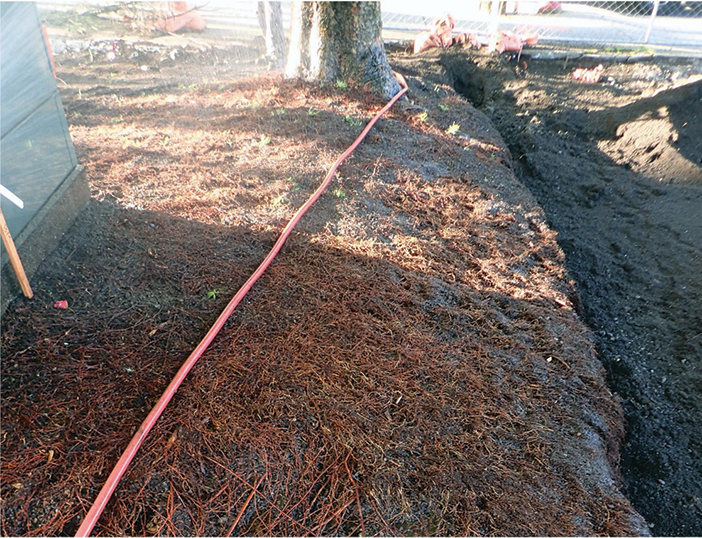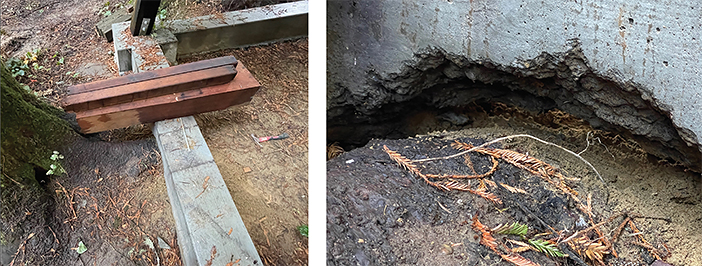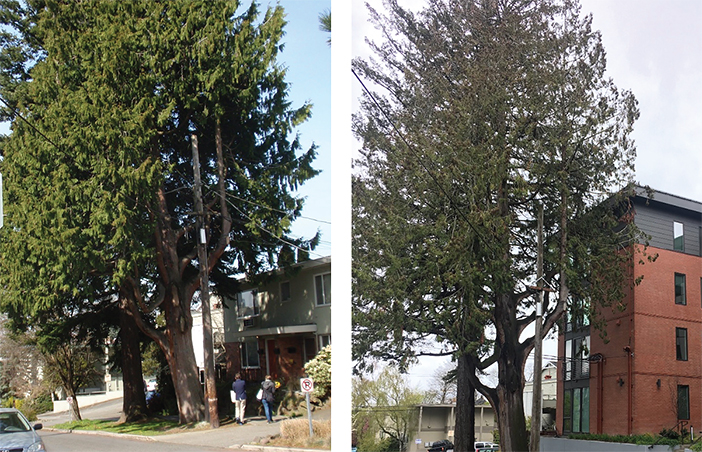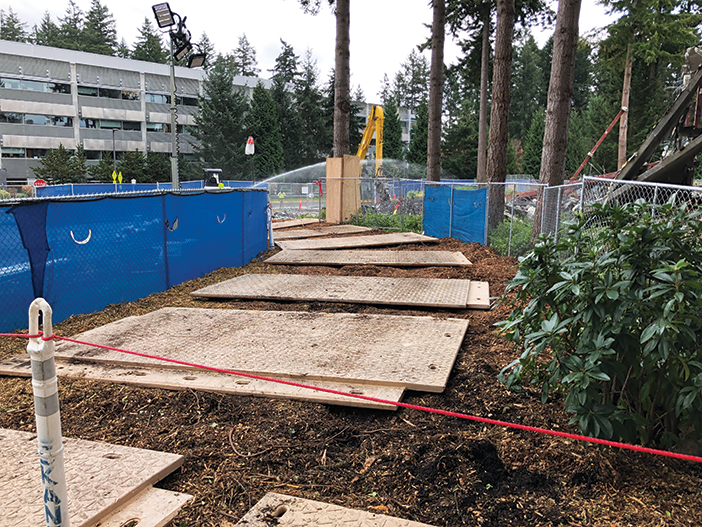It’s essential to protect the health of the trees at your aerial adventure course from the moment you start planning to build. A lot of unintentional damage can occur to trees during construction. Most of this is due to a lack of planning. Construction impacts can cause trees to become stressed and decline. In the worst case, they can cause structural instability leading to a hazard condition. The good news is that with a bit of planning, most damage can be avoided—at a relatively low cost.
Tree damage takes time to become noticeable. Construction impacts can take three to five years or more to appear, because trees have a lot of energy stored in them and it takes time for that energy to run low. Once symptoms of stress and decline become visible, though, it can be hard to restore a tree back to good health.
Building an adventure course among the trees poses a construction challenge, one where arborists try to keep work as far away from any trees as possible. To work in and around trees requires creativity, care, and diligence to limit the size of the work zone to the smallest feasible area. Each project will have unique characteristics that determine the best tree protection approach, so the guidance of an experienced arborist can prove extremely valuable.
COMMON CONSTRUCTION IMPACTS
It is easy to forget that a large part of the tree is unseen, growing underground. Trees have both structural roots that support stability and fine roots that are responsible for most of the water, oxygen, and nutrient exchange. Tree roots can grow very far away from the trunk of the tree if there is available soil and water, stretching out laterally from the tree in the top two to four feet of soil. While some trees have deep roots, more often we see such lateral root systems, with the most important roots residing in the top foot of soil.
Underground impacts. The most damaging impacts of construction projects come from actions that degrade the roots. These impacts typically come from two sources: ground disturbance, like digging or grading that severs the root system of a tree; and machine traffic or material storage that cause compaction. Soil compaction limits the amount of water and air available to the root system, suffocating and killing fine roots, which in turn causes the decline of a tree over time.
Removing part of a root system can be compared to knocking out a part of a building foundation. Unlike a building, trees can regenerate—but regeneration is a slow process. If the removed root is large, the tree may be left with a permanent structural deficit.
Above-ground impacts. Construction activity can wound tree trunks, break branches, and inflict other insults such as removing understory vegetation. Drilling holes in the trunk to accommodate hardware and fittings adds another layer of impact and a great deal of load to each tree.
All of this work must be carefully planned so that the project can be constructed with the minimum amount of disturbance.

The roots of four Douglas fir trees were uncovered to determine how close infrastructure could get to the trees. These roots were too large to sever without compromising the structural stability of the trees.

Using pressurized air, or pneumatic air tools, to excavate, as seen here, does the least damage to the root system of a tree, allowing the fine roots responsible for water and nutrient uptake to be retained.
WHAT IS TREE PROTECTION?
Tree protection is made up of physical protection barriers, carefully planned construction methods, and general maintenance conducted to help protect the health and structural stability of a tree.
So, when building a new project, in addition to all the usual experts like aerial course designers, builders, engineers, and architects, it’s important to hire an ISA-certified arborist or registered consulting arborist skilled in advising on development projects, ideally adventure course projects, to be a part of the planning and construction team.
Tree protection should be addressed throughout the lifespan of a project, starting in the planning phase and ending once construction is completed. A tree protection plan gives a builder a good sense of what the owner’s expectations are, what kinds of construction methods to use near trees, and what kinds of protection measures will need to be put in place. This will ensure that the work is bid accurately and that it goes smoothly.
DEVELOPING A PROTECTION PLAN
Site Assessment Phase: Developing an effective tree protection plan starts with the site assessment phase. In this stage, your arborist will assess the trees onsite and help you identify which are suitable to attach to or build nearby. We suggest engaging an arborist before buying or leasing a property to ensure that the trees onsite can support an adventure course, and to identify any potential problems like diseased centers or insect pest infestations.
What’s involved in a site assessment?
Inventory. The arborist should walk the site with the owner or project team to help identify what part of the site would be appropriate to build in based on the species, size, and condition of the trees present. This assessment should be done in coordination with designers and other consultants who are looking at features like topography and access. Once the project area is defined, the arborist will measure and assess all the trees in the area according to any municipal requirements to help inform planning.
Maintenance needs. During the initial assessment, the arborist may recommend management steps, such as pruning or tree removal. An advanced decay assessment may be needed to confirm whether a tree has the structural stability to carry a load.
Tree protection zone (TPZ). The tree protection zone is an approximate location of the portion of the root system that provides structural stability and supports tree health. While work may occur in the TPZ, it must be done with care and on the advice of an arborist. Know, too, that roots often grow far beyond the boundary of the TPZ.

Above left: Decks with ground mounts can allow a heavier platform structure to be installed in the trees. Above right: Bridging over the most sensitive part of a root system is an effective way of allowing your customers to get up close to trees while reducing the stress on the trees from ongoing soil disturbance.

Above: These photos show the footing for a ramp deck. Before the footing was framed and poured, a foam product was applied around a buttress root. Once the footing was framed and poured, the foam was removed, leaving the buttress root room to grow (right). This kind of planning gives a course longevity.
The TPZ is determined based on the species and size of the trees as well as any municipal requirement. A few different strategies are used to identify a tree protection zone, including the dripline of the canopy or a measurement based on the size of the trunk. For example, the ISA recommends a minimum of six times the trunk diameter, and evaluation of any existing infrastructure that may be limiting the root system.
Planning Phase: Following the site assessment is the planning phase. In this stage, the arborist will help you determine where and how to build in and near trees. This should include a plan for the long-term growth of the tree. This phase may add to the up-front cost, but reduce costs over the long term by reducing the amount of renovation that needs to happen over time.
The elements of the planning phase include:
Requirements. Make sure your project follows any local tree protection and retention requirements. Such regulations are becoming common, as canopy-cover loss has become a concern and as tree hazard conditions have been caused by construction. Both the ANSI/ACCT and ASTM standards touch on tree protection in their design and operations chapters. Be sure to consult the standards as you are planning your project.
Expert consultation and project team coordination. Ongoing communication will help the project team members consider each person’s area of focus while designing the course. The arborist in this stage will consult on how close construction can get to trees and how much impact a tree can handle based on the assessment of the trees and the arborist’s professional experience.
Plan review. An arborist should review the project plans to assess the proximity of construction disturbance near trees. Expect your arborist to ask questions like, “How wide is the trench near the tree?” “How deep is excavation?” and “How many holes will be drilled in the tree, and how large will they be?”
Good arborists will also ask questions about possible alterations to the plans that could reduce the impacts to trees, such as, “Can you move the utility line further away from the trees?” “Can roots be retained crossing the trench?” or “Can the footings of a deck be located based on where the structural roots actually are?” They may also provide guidance on where trails would be best located to preserve tree health, or methods to bridge or block access to sensitive root zones.

Above: An example of how long it can take for symptoms of stress from construction impacts to appear. In the first photo, prior to construction, the tree is healthy with dense green foliage. In the second photo, taken a few years after construction, the foliage is thinning and off color.

Above: Tree protection measures, including fencing and soil protection, are often required when work must occur within the tree protection zone.
Arborists will also warn when the impacts are too great and will require tree removal, or when they could create an elevated risk of tree failure. For example, a plan may show too many penetrations around one plane for the circumference of a tree, which could elevate the risk of breaking.
Involvement in early planning will allow these design considerations to be incorporated into your plans before they become a costly crisis or field change.
Construction planning. Your arborist should consult on the construction methods used near trees. Employing alternative or creative construction methods designed to retain roots and reduce impacts can allow work to be conducted closer to trees than would otherwise be possible. This may include alternative excavation methods, soil protection methods, recommendations for cantilevering or bridging over a root or portion of the root system, identifying access routes and material storage areas, and the type of fencing and soil protection that will be employed.
Tree protection specifications. All tree protection measures should be specified on the plans and in a written document to ensure the builder understands the owner’s goals and the scope of the work. This allows the builder to produce a realistic cost estimate or bid.
Construction Phase: In this stage, the arborist inspects the site to ensure that the tree protection measures, like fencing and soil protection, are installed according to the plan. The arborist will also look for potential unintended impacts that may alter the viability of a given tree or require management. He can also discuss alternative construction methods with the builder and spend time onsite for construction monitoring and assessment of impacts.
Construction inspection and monitoring. In addition, have an arborist onsite while digging occurs near trees. This ensures that digging is done in the right sequence, with as little impact and damage to roots as possible. This also allows the arborist to assess any underground impacts to the tree before backfilling occurs.
Your trees, and the roots that support them, are a resource that may be impossible to replace without waiting decades for new or re-growth. It’s worth the time and effort to get good help from the beginning and build your project the right way.






